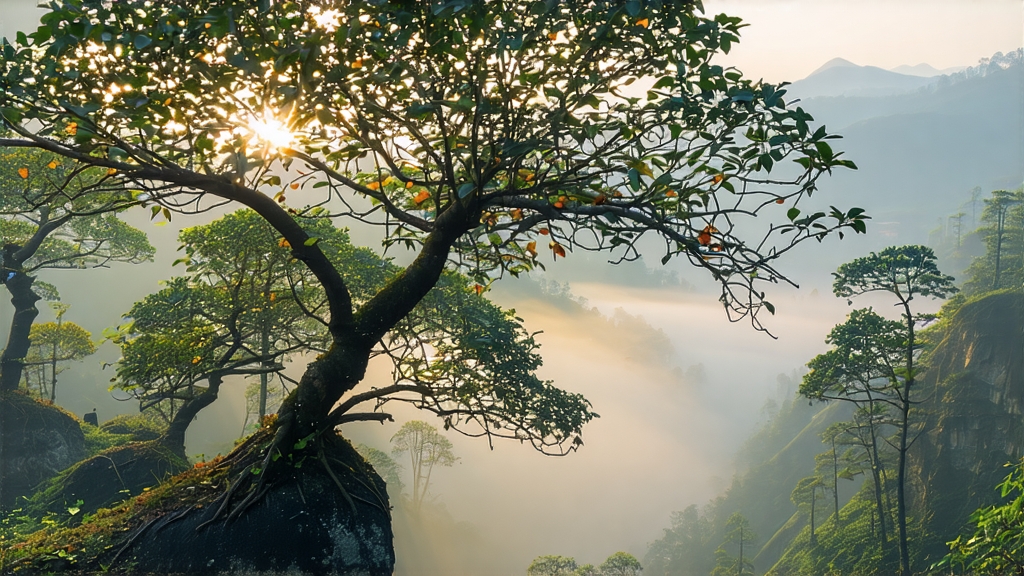
Tucked high on mist-capped Mengding Mountain in Sichuan Province, Mengding Huangya—literally “Yellow Bud from Mengding”—is the quietest celebrity in Chinese tea history. While Dragon Well and Da Hong Pao crowd teahouse menus, this golden-green gem once graced the porcelain cups of Tang-dynasty emperors, then slipped into near-oblivion for eight centuries. Revived in the 1950s by a handful of monks and agronomists, Mengding Huangya now offers the world a taste of China’s most enigmatic tea category: yellow tea, a style so labor-intensive that fewer than 200 master craftsmen still know how to make it properly.
Historical whispers begin in 725 CE, when the monk Wu Lizhen planted seven tea bushes on the summit of Mengding, an area Buddhists called “the place where the rain arrives first.” By the Song dynasty the buds were folded into imperial tribute lists, carried 1,500 km north by fast horses in bamboo-lined chests. Poets compared its liquor to “the first moonlight on melted snow,” and palace physicians prescribed it for “clearing summer heat and calming the dragon spirit of the emperor.” When Ming tea masters shifted fashion to greener, fresher tastes, yellow tea’s deliberate oxidation fell out of favor; state farms abandoned the technique during the 1930s wars. The bushes survived only because local monks secretly grafted cuttings onto wild rootstock hidden in temple gardens.
Botanically, Mengding Huangya belongs to the small-leaf Sichuan landrace Camellia sinensis var. sinensis ‘Shuchazao’, a cultivar that develops unusually high levels of theanine under cool cloud cover. Spring buds are picked for only ten days each year, when the leaf still curls like a sparrow’s tongue and the downy tip flashes ivory-yellow against morning mist. A single kilo requires 72,000 of these buds, all plucked before 9 a.m. while dew acts as natural protection against mechanical bruising.
The craft that turns green buds into yellow tea is called “sealed yellowing” (men huang). Within minutes of picking, the leaves are wok-fired at 160 °C for three minutes—just long enough to kill grass-green enzymes while preserving a core of moisture. They are then wrapped, still warm, in thick canvas bundles and placed inside a bamboo chamber whose temperature is maintained at 28 °C and 75 % humidity for 48 hours. During this sauna-like rest the leaf edges oxidize slightly, turning a pale champagne color, while the interior remains jade. The cycle of firing, wrapping and resting is repeated three times, reducing moisture to 10 % without ever exposing the leaf to direct sunlight. Finally the leaves are charcoal-roasted over a gentle fire of local birch wood, absorbing a whisper of smoke that later translates into the tea’s signature toasted rice note. The entire process consumes 72 attentive hours; one doze and the batch collapses into flat green tea or over-ferments into black.
To brew Mengding Huangya Western-style, use 3 g of leaf for 250 ml of water at 80 °C and steep three minutes; the liquor glows like chardonnay, releasing aromas of fresh corn silk, roasted chestnut and a trace of Sichuan pepper. For gongfu presentation, employ a porcelain gaiwan of 120 ml: quick-rinse the leaves, then infuse for 25 seconds, adding five seconds each subsequent steep. Across six infusions the flavor arcs from honeydew melon to steamed zucchini blossom, finishing with a cooling menthol sensation at the back of the throat. The emptied leaves, now the color of antique parchment, can be chewed; they taste faintly of nori and brown butter.
Professional cupping follows a four-step ritual. First, judge dry fragrance: warm the tasting cup, add 5 g of leaf, cover and shake; inhale deeply—top notes should recall magnolia and toasted sesame. Second, examine the wet leaf after a 90-second flash infusion; healthy buds lie flat like miniature canoes, edges tinted ochre, veins still jade. Third, assess texture: roll the liquor across the tongue while sucking in air; a silky, almost oily body indicates successful men huang. Finally, evaluate aftertaste; a lingering sweetness measured at the back molars should persist for at least 90 seconds, a phenomenon locals call “Mengding cave”—a reference to the mountain’s hidden grottos where echo lasts.
Storage is critical. Because yellow tea retains 3–4 % residual